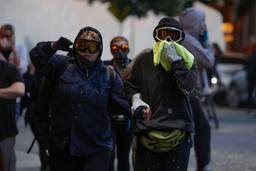As the oil spreads, choking life and livelihood, the hearings and investigations into BP’s gulf hemorrhage are focused on human failures, technical flaws and short-term fixes. These silos of inquiry, while essential, sidestep the deeper problem: Deep sea drilling is inherently risky, and continued use of fossil fuels means increasing reliance on tenuous technologies and dangerous energy sources.
One factor ramping up the risk lies in frigid sediments that have rested for eons 1,000 feet or more below sea and tundra. At that depth, hydrate gas (usually methane) is a stable solid, compressed into molecular cages of ice. But if destabilized by a drop in pressure or a rise in temperature, the gas-water compound can quickly expand 164 times in volume. If ignited, even ice-bound hydrates burn.
“The well-recognized hazard in offshore drilling is the formation of gas hydrates [that] could flow into the well bore from the reservoir (e.g., a kick),” U.K.-based scientist K. K. Østergaard wrote in a 2006 issue of Annals of the New York Academy of Sciences. “This could potentially block the [blowout preventer] stack, kill lines and chokes, obstruct the movement of the drill string, and cause serious operational and safety concerns” including blowouts.
“From 1980 to 2006 there were 165 blowouts in U.S. waters, with over 500 worldwide,” wrote independent researcher Dan Zimmerman in a well-documented September 2009 report to Minerals Management Service (MMS), “and hydrates were the main contributor.”
Although MMS ignored his warnings, even that industry-captive agency recognizes that pockets of hydrate gases should be “identified in advance of subsea development activities.” (Among industry’s few tools to prevent hydrate complications are toxic chemicals, including methanol and glycol, that end up in the environment.)
But the agency wrote in 2000, “The MMS believes that, in general, the oil and gas industry is doing a good job of screening for hydrates and taking preventative measures. This collaborative effort is promising.”
On April 20, that promise blew apart, taking with it 11 men, the lifeblood of hundreds of communities and the viability of an entire ecosystem for generations to come.
Many technical and human failures led to the destruction of the Deepwater Horizon drilling platform, but it looks as if hydrates played a key role. Just before the explosion, Halliburton was readying the well for production by pumping cement to fill the gap between the well casing and the blowout preventer. Curing cement produces heat that may in turn have released methane hydrate gases and sent them gushing to the surface, where they triggered the first explosion.
The risk was known. “Destabilization of hydrates during cementing and production in deepwater environments is a challenge to the safety and economics,” Halliburton had warned in a November 2009 presentation to the American Association of Drilling Engineers.
Deepwater Horizon’s hydrates problem goes back to at least March, when, after numerous “kicks” (sudden gas releases), BP officials informed federal regulators that they were struggling with a loss of “well control,” according to documents the New York Times obtained from congressional investigators.
Then, on April 15, five days before the disaster, BP acknowledged blockages, a problem associated with the frozen gases. But instead of stopping to get the well under control, BP continued work, hoping to complete drilling and cementing, before temporarily abandoning the well for later completion as a subsea producer. “BP was paying a half million dollars a day to lease the drilling rig [from Transocean],” says John Orcutt, distinguished professor of Geophysics at Scripps Institution of Oceanography. “I can imagine, under these circumstances, management decisions trumping engineering. Decisions under pressure can make you stupid, make you cut corners.”
“We don’t put enough pressure on industry to do enough,” says James Baker, a former head of the National Oceanic and Atmospheric Administration (NOAA) and a formerCommerce Department undersecretary for oceans and atmosphere. “MMS is in bed with industry, and part of that industry doesn’t want to spend the money for back-up systems.”
If BP cut the corners, MMS handed it a chainsaw. Capping a long-corrupted relationship with the oil and gas industry it is supposed to regulate, MMS signed off on continuing the well-capping operation after BP managed to produce successful results by dropping the pressure at which it was testing the blowout preventer from the usual 10,000 pounds per square to 6,500.
Despite BP’s rank by Public Citizen as having “the worst safety and environmental record of any oil company operating in America” (in a field rife with accident-prone corporations), MMS trusted the company to do the right thing.
“The MMS views methane hydrates as a performance issue and recognizes that having a hydrate mitigation plan is in the company’s best interest,” the agency wrote in 2000. “So far, companies have voluntarily avoided hydrate areas and, to date, no hydrate-related accidents have occurred during drilling in U.S. waters.”
Wrong, wrong, wrong. Corporate and public interests are often at odds; hydrates had long been implicated in accidents; and today’s deep wells cannot avoid the deposits. Like tar sands, whose exploration was previously too expensive, the hydrates’ star is rising in sync with oil prices and diminishing supplies of easy oil. The US Geological Survey’s (USGS) “conservative” estimate is that carbon bound in gas hydrates totals twice the amount of carbon to be found in all known fossil fuels on Earth.
Hydrates “eventually will be an energy source,” Orcutt predicts.
Despite the danger, “eventually” is rapidly approaching. In 2009, Chevron, with Department of Energy (DOE) funding, drilled seven wells in the Gulf of Mexico to test methane hydrate prospects. The next step is production. In Alaska, BP, the USGS and DOE are exploring large-scale production tests for exploiting the flammable hydrocarbons buried deep in the tundra. A BP-ConocoPhillips team is investigating the central North Slope of Alaska for production test sites.
“Actual drilling and testing operations, if we proceed, are likely to commence in 2011, and continue for 18 to 24 months,” BP spokesman Steve Rinehart told the Houston Chronicle.
Aside from the danger and costs – which currently make large-scale hydrate exploitation impractical – is the issue of greenhouse gases. Methane is more than 20 times more potent than CO2, and undersea and tundra drilling are already releasing vast quantities of the greenhouse gas into the atmosphere, where it supplements the rise in methane caused by global warming. It is not known whether the Obama administration’s policies on new drilling will include this unproven technology.
Nor do we know how much oil has spewed from BP’s gulf well or from numerous past disasters. One surprising revelation is that oil gushing from the failed blowout preventer has apparently coalesced into giant underwater plumes that hold far more of the leaked oil than surface slicks would predict. (BP CEO Tony Hayward denies that these plumes exist; Rep. Edward Markey (D-Mass.), chairman of a House Energy and Commerce Committee environmental panel, dubbed BP “Blind to Plumes,” and asked Hayward for evidence. )
It may turn out that these plumes have been part of many spills (especially when dispersants are used), but simply went undocumented until the clear disconnect between the volume of surface oil and the gushing spill-cam images brought them to light.
Washington and industry not only have joint custody of the accident, but shared impotence in staunching the flow or cleaning the mess. When it comes to assessing the damage, however, government and academic institutions have far more expertise than BP. “The oceanographic institutes and NOAA are the experts,” says Baker, who has recently consulted for the Intergovernmental Oceanographic Commission’s Global Ocean Observing System. “I am disappointed with government. NOAA must step up. We need to make comprehensive measurements of the spill and what’s in the water columns.”
“While government has claimed that scientists have been broadly consulted, this does not seem to be the case in practice,” Orcutt says.
BP’s failure to disclose the risks and its inability to control the consequences of losing its massive gamble in the gulf have sparked rage and charges that it violated an essential social contract: The public may decide to accept big risks to reap big benefits, but that decision must be based on hard, fully disclosed, independently assessed evidence.
Meanwhile, evidence of how dangerous deepwater drilling is, and how often BP deceived the public, should be enough to void that contract. In his excellent blog at DirtDiggersDigest.org, Phil Mattera calls for BP to be federalized. “For BP, job one is now not clean-up but cover-up,” Mattera writes. “Allowing it to manage the ongoing response would be akin to allowing the prime suspect in a mass murder to assist in processing the crime scene.”
But beyond crimes and punishments, triggers and fixes, are fundamental issues. “We need much more extensive changes in how we power the planet,” Orcutt says. “Right now it’s kind of hopeless when I listen to the news and government heads.”
The short history of deep-water drilling has been marked by accidents. Sophisticated technology and a multiplicity of fail-safe devices have failed: They leak, they explode, they poison the environment and they kill people. But when technology-based industries like oil drilling and nuclear power are tainted by greed, conflicts of interest, inadequate regulation and short-term thinking, catastrophes are not accidents – they are predictable outcomes.
If ever there was an argument for putting public welfare over corporate profits and for establishing science-based regulatory bodies free from conflicts of interest, oil drilling and nuclear power – with their unavoidable and planet-threatening risks – are it. But beyond safety is sanity: Government must not only regulate industry, but must mandate and subsidize sustainable, green energy. Whatever the price, it is cheap compared to the costs of the current path.









